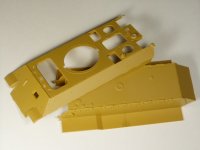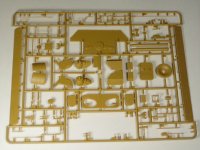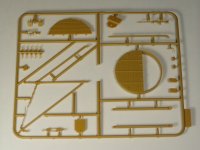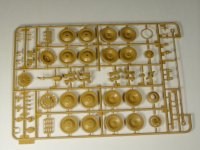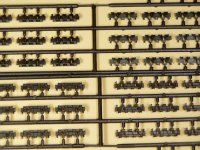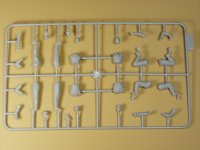ICM's 1/35 Bergepanther with German Tank Crew
|
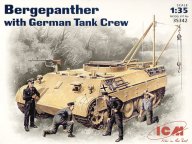 |
Bergepanther
When the first units equipped
with Tigers and Panthers entered service, it was realized that heavier
recovery vehicles were needed. It took three of the 18-ton Famo half-tracks
to tow a Tiger, and even the lighter Panthers were a serious challenge.
In 1944 development of a special recovery version of the Panther was requested
by the Army. Basic Panther hulls, minus their turrets, were fitted with
a powerful winch, and a heavy ground spade was installed on the rear of
the hull. These vehicles were fitted with improved gearing and increased
fuel capacity, and in some cases a 2cm. autocannon or MG 34 or MG 42 for
self protection. Some vehicles, minus the winching gear and rear ground
spade, were fielded as service vehicles, and some as ammunition and stores
replenishment vehicles. A total of 297 vehicles were converted and served
until the end of World War II.
The Kit
This early Bergepanther kit is based on the hull and running gear of
the Panther D chassis. It consists of 409 parts, 216 of which are individual
track links. A one piece lower hull with side sponsons, full one piece
upper hull with all hatches and grills separately molded, and 4 sprues
of other parts are molded in medium tan plastic. 4 black sprues of track
links, and one gray sprue containing parts for a 4 man crew complete the
parts inventory. A 6 page instruction sheet is provided, including a parts
map and paint guide. Colors are referenced to Testor's Model Master enamel
paints. Highlighted parts on the parts map indicate that a turreted gun
tank is also produced.
4 sprues of track links, containing 54 links each, show minor flash
on some links. Each link has 2 ejector marks on the outer face, but they
are not deep. They closely resemble those from Model Kasten's early offerings.
There are enough links for both track runs and some spares. The figures
consist of a commander and three others in working poses, 2 of whom are
in work fatigues. The faces are nicely done, with varied expressions,
and one with a bare head. Uniform detail is nicely rendered. There is
very minor flash on a couple of the hands. The mold seams are light, and
appear to be easily removed.
Two of the parts sprues are duplicates, containing the wheels and torsion
bar arms, sprockets, idler wheels, and engine deck grills. Surface detail
is quite crisp, with subtle cast texture visible on the appropriate parts.
The lower hull has all the access ports molded on the bottom, as well
as torsion bar collars and anchor points on the side walls. The road wheels
have a different texture on the rubber tire portions versus the wheels.
The welded joints and cut edges of the armor plates are well rendered.
The rear stowage bins have nicely detailed separate lids. Delicate width
indicators are provided for the front fenders, which have the early curved
extensions, held on by tiny, delicately cast individual wing nuts. The
exterior tools are cleanly cast, showing round molded-on clasps. None
of the interior winch structure is included in the kit, nor is the commonly
seen rear mounted ground spade. The turret opening is closed by a two-part,
wood-grained round cover, again secured by tiny wing nuts. This served
as a work surface and weather cover, and exhibits nice wood texturing.
The 1 1/2 ton capacity movable lifting derrick is well rendered, with
nice chain and cable detail. It can be assembled and placed on either
side of the upper hull. Separate towing bars and stowage brackets are
supplied. The oversized rear towing pintle installed on the Bergepanthers
is well done.
Markings are limited to 3 black and white Balkan crosses, well printed
and registered, on thin decal film. Paint options for two vehicles are
shown, though one is labeled for Kursk, 1943, before the first vehicles
were produced. One vehicle is in overall dark yellow, while the second
is dark yellow with medium green wavy lines.
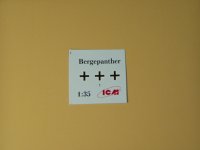
Assembly starts with the lower hull, installing torsion bar arms, final
drive housings, road wheels, rear plate and exhausts. (Steps 1 through
12) Work then moves to the interior of the upper hull, with vision ports,
periscopes, transmission access plate and hatches installed. Upper and
lower hulls are mated, with upper hull details added. Tracks are assembled
and installed at step 23, though it might be easier to do this sooner,
before the small upper hull details are added. The final details are then
added, with the building of the lifting jib, towing bars, and rear towing
pintle. One thing to watch for is that the parts are numbered on the instruction
sheet, with the letter of the sprue, but no numbers are engraved on the
sprues themselves.
Conclusion
Overall, I have to say this is a very nice kit. I was less impressed
with some of the earlier offerings from ICM, but this one is different.
With crisp detail, very rare instances of flash,and some nicely cast delicate
fasteners, this is a winner. Filling the ejector marks on the tracks,
though tedious, should not be difficult. The crew figures are well done,
though the normal complement was five men. I recommend this kit, especially
as it is only the second injection molded offering of this vehicle. My
thanks to ICM for the review sample.
I look forward to building this one.
|
|

